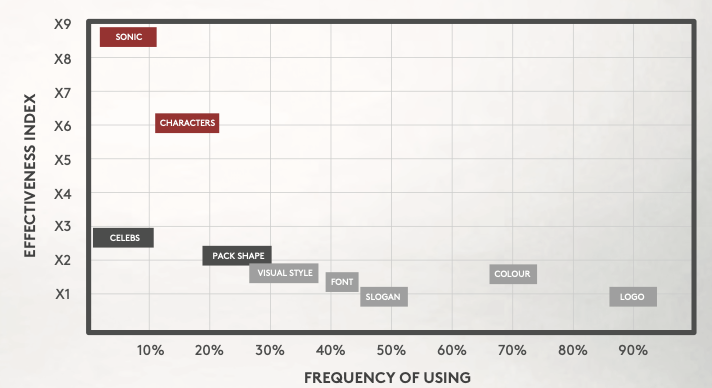This year our 16th annual brandgym research project looks at how to fully harness the potential of distinctive brand assets to drive growth. In this second of two posts, we look at a strategic approach for creating, measuring and amplifying brand assets to drive distinctiveness.
1. MEASURE Brand Assets
A first key step in managing brand assets more strategically is to start using quantitative measurement. Currently, less than half of marketers surveyed (46%) are using such a quantitative method to guide brand asset changes. 19% use qualitative research and 1/3 are basing important brand asset decisions on judgement alone.

A quantitative study, such as Iconic Asset Tracking (IcAT) we use on brandgym projects, gives hard data on your most distinctive assets. To illustrate this approach, see the study below on Red Bull done with partner insight agency Distinctive BAT, which measures assets on two key dimensions: 1. recognition, 2. brand attribution.
The distinctive design, including the bull and blue & white colours, create a strong foundation for the brand. These assets have been consistently amplified across touchpoints, including the Red Bull cars which score very highly. The memorable tagline and illustration style advertising are also highly distinctive.

2 CREATE & AMPLIFY Brand Assets
AMPLIFY Distinctive Brand Assets
The ideal result from Iconic Asset Tracking will be the identification of one or more DBAs: easily recognisable assets that are attributed to your brand. In this case, the key challenge is then to work on amplifying the brand asset(s). Importantly, this work should be a collaboration among creative agencies, to ensure amplification across all key touchpoints.
This was the approach used by biscuit brand BN who identified the smile in the biscuit as a key DBA that could be better amplified across the whole mix, as we posted on here.

CREATE Distinctive Brand Assets
There are cases where Iconic Asset Tracking reveals a lack of any brand assets that are distinctive. Here, the challenge is to build one or more DBAs. Again, it is critical that this work involves a cross-agency brief, with close collaboration. This encourages the creation of a brand asset that can be amplified across all key channels.
When creating a new brand asset, characters and sonic devices are worth considering. These asset types are highlighted as the least used but most effective in IPSOS research (see below), being 6x and 9x more present in high performing ads than average, as we posted on here.

3. TRACK & TREASURE Brand Assets
Once you have identified and started to amplify key brand assets, it is important to track them. Currently, only 21% of companies have such tracking in place.
For example, several brands have ‘flattened’ their logos to ease application in social media as we posted on here. Using ongoing tracking such as that provided by Distinctive BAT would have shown the companies concerned how this move has significantly decreased distinctiveness (see below).

A mere 10% of companies apply very well the principle of consistently amplifying brand assets over time to build memory structure. Almost half are not applying well at all these principles. A rigorous, insight-led approach is needed for decision making on DBAs. After all, A CEO would never approve destroying a physical asset like a factory without hard data. The same should apply to brand assets, which just as valuable!
In conclusion, to fully achieve the potential of brand assets to drive growth, you need a strategic, insight-led approach to creating, measuring and managing them.
